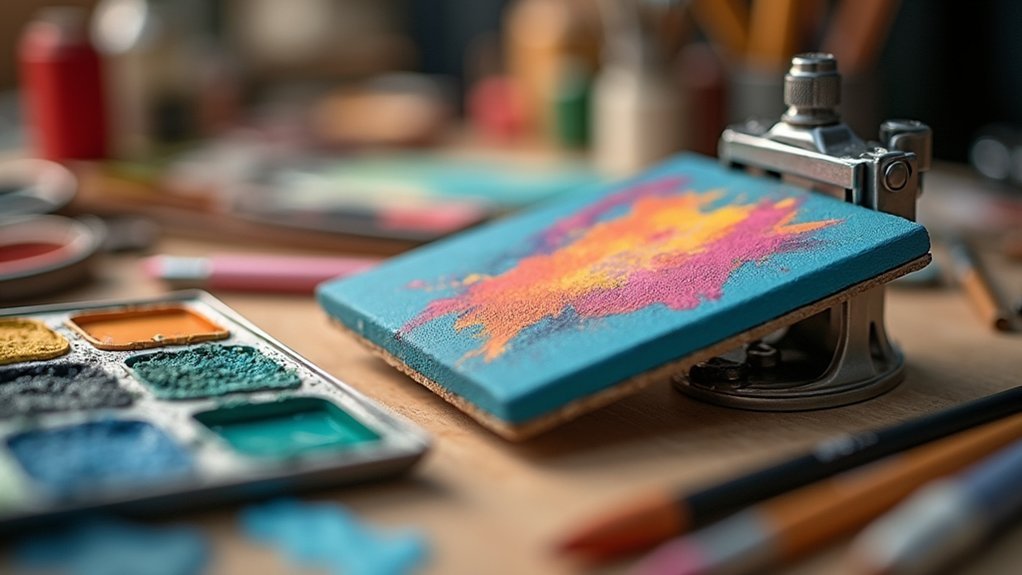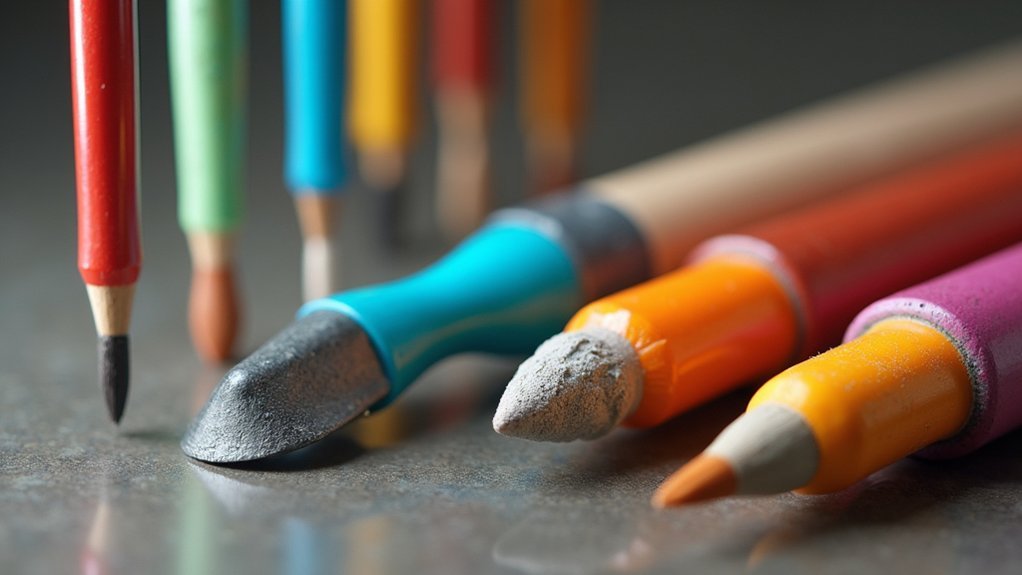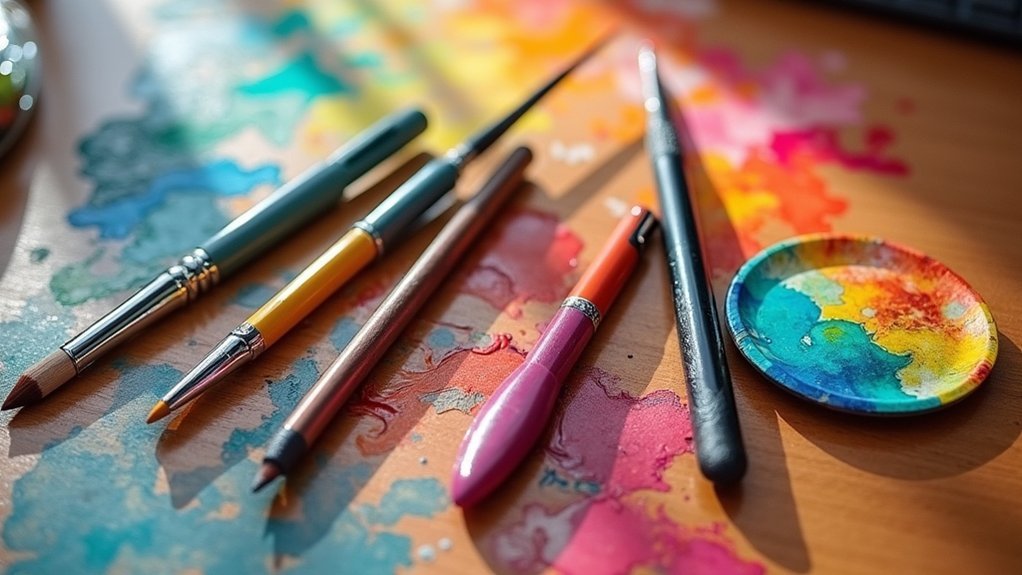One-handed art tools open creative possibilities despite mobility challenges. Try the Clamp-It Hobby Vise to secure projects while you work, precise hemostats for gripping small components, palm gouges for controlled woodcarving, adaptive non-slip mats to prevent materials from shifting, and specialized handle modifications for improved grip on brushes and pencils. These accessible options promote independence and artistic expression without requiring traditional two-handed techniques. Discover how these tools can transform your artistic practice.
Clamp-It Hobby Vise: Your Craft Stabilizing Assistant

Frustration dissolves when you have an extra hand for your creative projects. The Clamp-It Hobby Vise delivers exactly that, securing your work while you focus on precision and technique.
Say goodbye to project frustration—the Clamp-It Hobby Vise becomes your steady extra hand when precision matters most.
This versatile tool clamps easily to any tabletop, providing stability for woodworking, jewelry making, model building, and various DIY projects.
You’ll appreciate its full rotation capability, allowing you to position your work at any angle necessary for ideal access. The swivel head offers 360° rotation and can tilt up to 45° for optimal positioning of your workpiece.
With both soft and hard jaw options, you’re equipped to handle delicate materials or sturdy pieces without damage. The adjustable width accommodates different-sized projects, while grooved plates provide excellent grip for cylindrical objects.
Weighing just 1.9 pounds with quick-release mechanisms, you’ll find it’s portable enough to move between workspaces without sacrificing functionality.
Palm Gouges and Adzes for Woodcarving Freedom
Woodcarving enters its most liberating form when you can hold your tool in one hand while manipulating your workpiece with the other.
Palm gouges, with their compact 5.5-6 inch length and ergonomic handles, offer you unparalleled control for both roughing and detailing work. Flexcut designs are specifically engineered for precision woodcarving with comfortable ergonomics.
- Choose your profile wisely – shallow #5 gouges for smoothing surfaces, medium #7 for detailing, and deep #9 gouges for creating valleys and undercuts.
- Look for high-quality tool steel (HRC59-61) with precision sharpened edges that minimize friction and prevent clogging.
- Invest in versatile V-tools (45°-60°) and bent blades for accessing complex areas, especially useful in relief and caricature carving.
Premium sets from BeaverCraft, Stubai, or Dastra range from $70-90, with individual tools available for $15-20.
Hemostats: Precision Gripping for Delicate Projects

Precision artists recognize the indispensable value of hemostats when working on intricate details that require steady, unwavering control.
These surgical-grade stainless steel tools offer a secure grip with adjustable locking positions, freeing your hand for complementary tasks while maintaining constant pressure on delicate components.
You’ll appreciate hemostats’ versatility across jewelry-making, textile work, ceramics, and miniature modeling.
Their compact 4-5 inch size enhances maneuverability in tight spaces, while ergonomic handles reduce fatigue during extended use.
Choose between straight or curved nose options to match your specific needs.
The one-handed operation makes hemostats particularly valuable for artists with limited dexterity.
Their textured grips improve stability while the fine tactile feedback helps you sense grip force without damaging fragile materials.
For permanent jewelry projects, many professionals prefer models with black-coated handles that provide superior grip and comfort during extended welding sessions.
Adaptive Mats and One-Handed Plates for Material Control
While hemostats offer exceptional grip for small objects, keeping your work surface stable presents another challenge for one-handed artists.
Adaptive mats and specialized plates solve this problem by securing your materials and tools in place while you work.
- Non-slip surfaces prevent sliding and shifting – look for textured silicone mats that grip both your table and materials, or plates with suction cup bases that stay firmly anchored to your workspace.
- Built-in compartments keep supplies organized and within reach – plates with dividers eliminate the need to juggle multiple containers.
- DIY options make these tools accessible – repurpose cutting boards with added grip pads or use binder clips on placemats to create affordable alternatives that still provide stability. Weighted add-ons can be incorporated to further improve the stability of your materials when working with one hand.
Specialized Handle Modifications for Traditional Art Tools

Traditional art tools often present challenges for one-handed artists, as their standard designs presume the use of both hands for ideal control and precision.
Fortunately, several modifications can transform these tools into one-hand-friendly implements.
Silicone grip extenders stretch to fit various brush sizes, providing additional surface area and stability. Easy Hold silicone grip extenders accommodate various brush sizes while improving control for artists with disabilities. You’ll find egg-shaped handles particularly effective, as they fit naturally in your hand while reducing strain.
For personalized solutions, consider creating custom handles from hardwood—shorter, thicker designs with curved contours prevent slipping and enable controlled movements.
Surface treatments like light oiling on wooden handles improve grip while maintaining tactile feedback.
Consider textured surfaces to increase friction and reduce effort during extended sessions.
For maximum comfort, custom-molded grips using thermoplastics can conform precisely to your unique hand shape, greatly enhancing control and accessibility.
Frequently Asked Questions
How Do I Finance My One-Handed Art Tool Collection?
Consider art-backed loans using existing collections as collateral. You’ll retain ownership while accessing funds for purchases. Explore specialized financing services, personal loans, grants for disability initiatives, crowdfunding, or credit cards with 0% APR offers.
Can One-Handed Art Tools Be Effectively Used by Children?
Yes, children can effectively use one-handed art tools. You’ll find they support fine motor development, boost confidence, and allow creative expression. Many are specifically designed with larger grips and ergonomic features for smaller hands.
Where Can I Find Community Workshops for One-Handed Artists?
You’ll find one-handed artist workshops at Angels Gate Cultural Center, Brentwood Art Center, Armory Center for the Arts, Wayne Art Center, and Rhiannon Klee Art. These venues offer inclusive ceramics, painting, digital, and collage classes.
Are There Certification Programs for Teaching One-Handed Art Techniques?
Currently, you won’t find specialized certifications specifically for teaching one-handed art techniques. Consider adapting existing art education programs or creating your own workshop curriculum to fill this niche in accessibility education.
How Do Seasonal Changes Affect the Performance of Adaptive Tools?
Temperature fluctuations affect your adaptive tools considerably. In winter, plastics become brittle. Summer heat softens grips. Humidity alters textures. Seasonal changes also impact your dexterity and mood when using these tools.
In Summary
Don’t let physical limitations define your artistic journey. You’ve discovered five powerful tools that transform one-handed creativity from challenging to intuitive. Whether you’re stabilizing projects with the Clamp-It vise or making precise adjustments with hemostats, these adaptations open new possibilities. Your artistic vision deserves expression, regardless of ability. Try these tools, experiment with modifications, and you’ll find your creative process becoming more accessible and enjoyable every day.





Leave a Reply